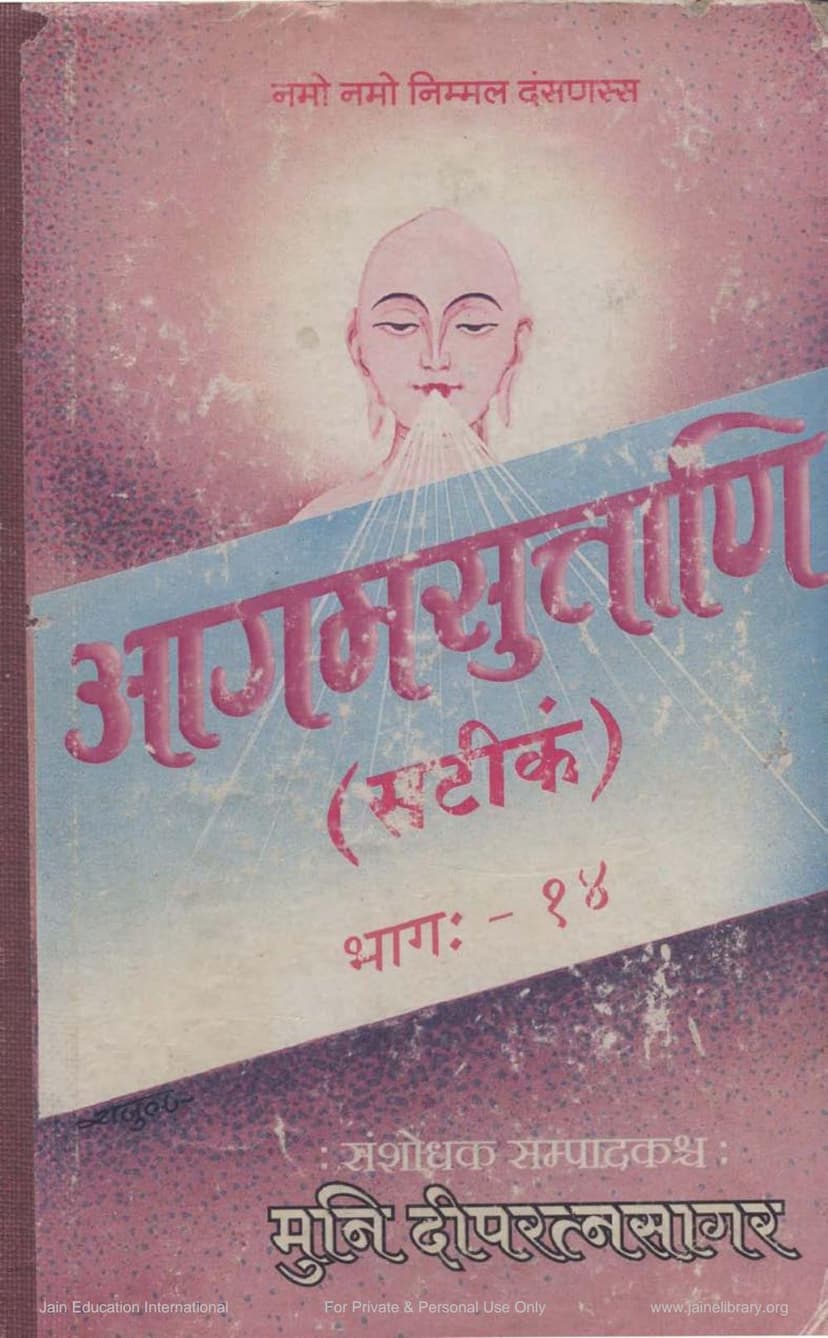Agam Sutra Satik 20 Kalpavatansika UpangSutra 09
Added to library: September 1, 2025

Summary
This document is Volume 14 of the "Agam Sutra Satik" series, published by Agam Shrut Prakashan. It focuses on the Kalpavataṃsikā Upāṅga Sūtra, which is identified as the ninth Upāṅga Sūtra. The text is presented in Sanskrit with a commentary (likely vṛtti) by Chandra Sūri, as indicated by the title "Satik".
Here's a breakdown of the content based on the provided pages:
Overall Scope and Structure:
- Series: Agam Sutra Satik (with commentary)
- Volume: 14
- Sūtras Covered: This volume includes several Upāṅga Sūtras and Prahīrṇaka Sūtras. Specifically:
- Nirayāvalikā Upāṅga Sūtra (निरयावलिकाउपाङ्गसूत्रं)
- Kalpavataṃsikā Upāṅga Sūtra (कल्पवतंसिकाउपाङ्गसूत्रं)
- Puṣpikā Upāṅga Sūtra (पुष्पिकाउपाङ्गसूत्र)
- Puṣpacūlikā Upāṅga Sūtra (पुष्पचूलिका उपाङ्गसूत्रं)
- Vṛṣṇidaśā Upāṅga Sūtra (वृष्णिदशाउपाङ्गसूत्र)
- Catuḥśaraṇa Prahīrṇaka Sūtra (चतुःशरणप्रकीर्णकसूत्र)
- Mahāpratyākhyāna Prahīrṇaka Sūtra (महाप्रत्याख्यानप्रकीर्णकसूत्र)
- Bhakta Parijñā Prahīrṇaka Sūtra (भक्तपरिज्ञा प्रकीर्णकसूत्र)
- Tandula Vaicārika Prahīrṇaka Sūtra (तंदुलवैचारिक प्रकीर्णकसूत्र)
- Saṃstāraka Prahīrṇaka Sūtra (संस्तारक प्रकीर्णकसूत्र)
- Gacchaācāra Prahīrṇaka Sūtra (गच्छाचारप्रकीर्णकसूत्र)
- Gaṇividyā Prahīrṇaka Sūtra (गणिविद्याप्रकीर्णकसूत्र)
- Devendra Stava Prahīrṇaka Sūtra (देवेन्द्रस्तवप्रकीर्णकसूत्र)
- Maraṇasamādhi Prahīrṇaka Sūtra (मरमसमाधिप्रकीर्णकसूत्र)
- Editor/Compiler: Muni Deepratnasagar (मुनि दीपरतनानागार / मुनि दीपरत्नसागर)
- Purpose: The series aims to provide the Jain Agamas with commentaries, making them accessible for study.
- Content Page (Page 3-6): A detailed table of contents (विषयानुक्रम) lists all the Sūtras and their respective studies (अध्ययन), chapters (द्वार), or sections, along with their starting page numbers. This demonstrates the comprehensive nature of the volume.
Focus on Kalpavataṃsikā Upāṅga Sūtra (Pages 8-10):
- Identification: The Kalpavataṃsikā Upāṅga Sūtra is the ninth Upāṅga and is presented with its original text (mūla sūtra) and the commentary (vṛtti) by Chandra Sūri.
- Structure: The Kalpavataṃsikā is divided into ten studies (adhyayana).
- Content of Studies:
- Study 1 (Padma): This study describes the story of Padma, a prince of Champā. It details his birth, his ascetic vows, his practice of various austerities (like chaturth-shashth-ashtam tapas), his passing away, and his rebirth as a deity in the Saudharma heaven, with a lifespan of two sāgaropama. It mentions that after exhausting his lifespan there, he will eventually achieve liberation (siddha) in Mahāvideha.
- Study 2 (Mahāpadma): Similar to the first study, this details the story of Mahāpadma, another prince. It describes his asceticism and rebirth as a deity in the Īśāna heaven with a lifespan of two sāgaropama, also destined for liberation in Mahāvideha.
- Studies 3-10: The text states that these remaining studies follow a similar pattern. The names of the sons and their respective ascetical practices and rebirths as deities in higher heavens (Śatakumāra, Māhendra, Brahmaloka, Lāntaka, Mahāśukra, Sahasrara, Prāṇata, Ācyuta) are outlined, along with their lifespans (measured in sāgaropama). The commentary (vṛtti) explains a concluding verse that details the duration of the ascetic practices for the ten princes' sons (e.g., five years, four years, three years, two years). It explicitly states that after enjoying celestial life, they will eventually attain liberation in Mahāvideha.
- Significance: The Kalpavataṃsikā seems to describe the lives and ascetic paths of various princes who, after renouncing worldly pleasures and practicing severe austerities, attain heavenly states and eventually liberation. This highlights the Jain emphasis on renunciation, penance, and the path to liberation.
Additional Information:
- Dedication: The text includes dedications and acknowledgments to various spiritual teachers and patrons who supported the publication.
- Tables: Several pages (11-25) provide detailed tables listing the Jain Agamas, their commentaries, the number of verses (śloka pramāṇa), and the authors of these commentaries and glosses (vṛtti, bhāṣya, cūrṇi). This is a valuable resource for understanding the scholarly tradition behind the Agamas.
- Sūtra Structure: The text also includes a section (Page 17-19) that explains the structural divisions of various Agamas (like śrutaskandha, cūlā, adhyayana, uddeśaka, mūla, pratiipatti, dvāra), indicating how the scriptures are organized.
- Publication Details: The publication information (Publisher, contact details) is clearly provided.
In essence, this volume of the "Agam Sutra Satik" series offers a scholarly presentation of the Kalpavataṃsikā Upāṅga Sūtra, detailing the stories of princes who achieved spiritual progress through asceticism, leading to celestial existence and ultimate liberation. It is part of a larger effort to publish and preserve the vast Jain scriptural tradition.